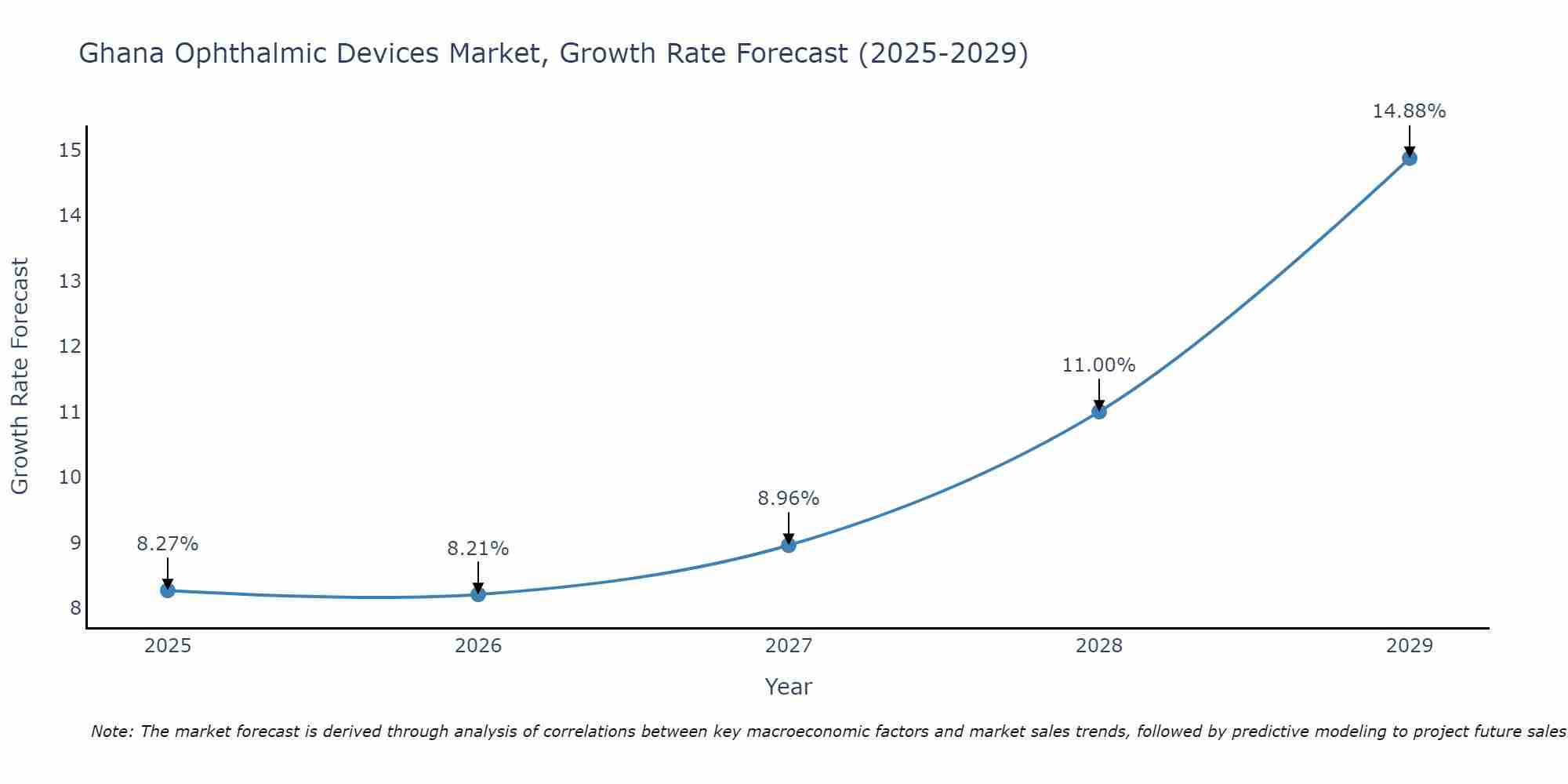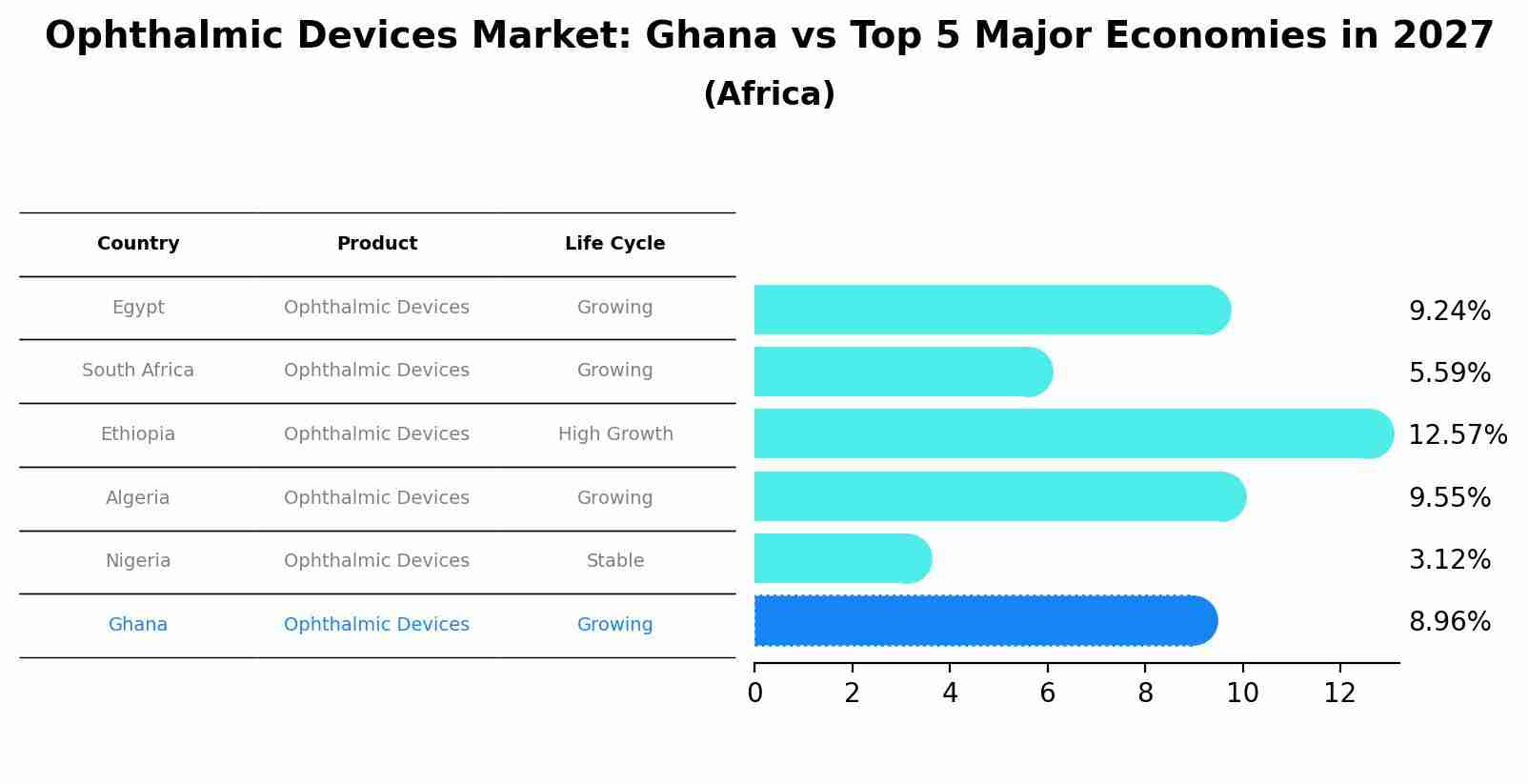Ghana Ophthalmic Devices Market (2025-2031) Outlook | Analysis, Size, Companies, Growth, Industry, Share, Value, Trends, Revenue & Forecast
| Product Code: ETC367916 | Publication Date: Aug 2022 | Updated Date: Jul 2025 | Product Type: Market Research Report | |
| Publisher: 6Wresearch | Author: Bhawna Singh | No. of Pages: 75 | No. of Figures: 35 | No. of Tables: 20 |
Ghana Ophthalmic Devices Market Size Growth Rate
The Ghana Ophthalmic Devices Market is projected to witness mixed growth rate patterns during 2025 to 2029. From 8.27% in 2025, the growth rate steadily ascends to 14.88% in 2029.

Ophthalmic Devices Market: Ghana vs Top 5 Major Economies in 2027 (Africa)
The Ophthalmic Devices market in Ghana is projected to grow at a growing growth rate of 8.96% by 2027, within the Africa region led by Egypt, along with other countries like South Africa, Ethiopia, Algeria and Nigeria, collectively shaping a dynamic and evolving market environment driven by innovation and increasing adoption of emerging technologies.

Ghana Ophthalmic Devices Market Synopsis
The Ghanaian Ophthalmic Devices Market is experiencing steady growth driven by factors such as increasing prevalence of eye disorders, growing awareness about eye health, and improving healthcare infrastructure. The market comprises a wide range of products including diagnostic devices (such as fundus cameras and optical coherence tomography machines), surgical instruments (like phacoemulsification systems and vitrectomy machines), and vision care products (such as contact lenses and glasses). Key players in the market include both local distributors and international manufacturers who are expanding their presence in Ghana. The market is characterized by a competitive landscape, technological advancements, and efforts to enhance access to eye care services in both urban and rural areas. Overall, the Ghana Ophthalmic Devices Market presents opportunities for growth and innovation in the coming years.
Ghana Ophthalmic Devices Market Trends
Currently, the Ghana Ophthalmic Devices Market is experiencing a growing demand for advanced diagnostic and surgical equipment due to an increasing prevalence of eye disorders and a growing awareness about eye health. Technological advancements such as the integration of artificial intelligence and robotics in ophthalmic devices are gaining traction in the market, leading to more accurate diagnosis and precise surgical procedures. Additionally, there is a rising trend towards minimally invasive surgeries in ophthalmology, driving the adoption of devices such as phacoemulsification systems and femtosecond lasers. The market also sees a growing focus on teleophthalmology solutions to improve access to eye care services in remote areas. Overall, the Ghana Ophthalmic Devices Market is witnessing a shift towards innovative and efficient technologies to enhance patient outcomes and address the increasing burden of eye diseases.
Ghana Ophthalmic Devices Market Challenges
One of the key challenges faced in the Ghana Ophthalmic Devices Market is the limited access to advanced technology and high-quality products due to the country`s relatively underdeveloped healthcare infrastructure. This leads to a lack of availability of cutting-edge ophthalmic devices, which hinders the ability of healthcare providers to deliver optimal eye care services to the population. Additionally, the high cost associated with importing ophthalmic devices poses a significant barrier for both healthcare facilities and patients in Ghana. Furthermore, there is a shortage of skilled ophthalmologists and eye care professionals in the country, which affects the adoption and effective utilization of ophthalmic devices. Addressing these challenges through investments in infrastructure, training programs, and affordability initiatives is crucial to improving eye care services and outcomes in Ghana.
Ghana Ophthalmic Devices Market Investment Opportunities
The Ghana ophthalmic devices market presents promising investment opportunities due to the increasing prevalence of eye diseases, rising healthcare expenditure, and growing awareness about eye health in the country. Key areas for investment include diagnostic equipment such as optical coherence tomography and fundus cameras, surgical instruments like phacoemulsification systems and vitrectomy machines, as well as vision care products such as contact lenses and spectacles. With a growing elderly population and a rising demand for quality eye care services, investing in innovative ophthalmic technologies and devices tailored to the Ghanaian market can offer significant returns. Additionally, partnerships with local healthcare providers and government initiatives to improve eye care services can further enhance the investment potential in the Ghanaian ophthalmic devices market.
Jordan Agar Market Government Policies
The Ghanaian government has implemented various policies to regulate the Ophthalmic Devices Market in the country. These policies aim to ensure the quality and safety of ophthalmic devices imported and used in Ghana by enforcing strict registration and licensing requirements for manufacturers and distributors. Additionally, the government has established guidelines for the importation and distribution of ophthalmic devices to ensure compliance with international standards and best practices. Furthermore, there are regulations in place to monitor the pricing of ophthalmic devices to prevent price gouging and ensure affordability for consumers. Overall, these government policies play a crucial role in safeguarding public health and promoting the growth of the Ophthalmic Devices Market in Ghana.
Ghana Ophthalmic Devices Market Future Outlook
The Ghana ophthalmic devices market is poised for growth in the coming years due to factors such as increasing prevalence of eye diseases, rising geriatric population, and improvements in healthcare infrastructure. Technological advancements in ophthalmic devices, such as advanced diagnostic equipment and minimally invasive surgical tools, are also driving market expansion. Additionally, government initiatives to enhance eye care services and increase awareness about eye health are expected to further boost market growth. As the demand for quality eye care services continues to rise in Ghana, the ophthalmic devices market is likely to witness steady growth and present opportunities for both domestic and international manufacturers to expand their presence in the country.
Key Highlights of the Report:
- Ghana Ophthalmic Devices Market Outlook
- Market Size of Ghana Ophthalmic Devices Market, 2024
- Forecast of Ghana Ophthalmic Devices Market, 2031
- Historical Data and Forecast of Ghana Ophthalmic Devices Revenues & Volume for the Period 2021 - 2031
- Ghana Ophthalmic Devices Market Trend Evolution
- Ghana Ophthalmic Devices Market Drivers and Challenges
- Ghana Ophthalmic Devices Price Trends
- Ghana Ophthalmic Devices Porter's Five Forces
- Ghana Ophthalmic Devices Industry Life Cycle
- Historical Data and Forecast of Ghana Ophthalmic Devices Market Revenues & Volume By Product for the Period 2021 - 2031
- Historical Data and Forecast of Ghana Ophthalmic Devices Market Revenues & Volume By Optical Coherence Tomography Scanners for the Period 2021 - 2031
- Historical Data and Forecast of Ghana Ophthalmic Devices Market Revenues & Volume By Fundus Cameras for the Period 2021 - 2031
- Historical Data and Forecast of Ghana Ophthalmic Devices Market Revenues & Volume By Perimeters/Visual Field Analyzers for the Period 2021 - 2031
- Historical Data and Forecast of Ghana Ophthalmic Devices Market Revenues & Volume By Autorefractors and Keratometers for the Period 2021 - 2031
- Historical Data and Forecast of Ghana Ophthalmic Devices Market Revenues & Volume By Ophthalmic Ultrasound Imaging Systems for the Period 2021 - 2031
- Historical Data and Forecast of Ghana Ophthalmic Devices Market Revenues & Volume By Ophthalmic Pachymeters for the Period 2021 - 2031
- Historical Data and Forecast of Ghana Ophthalmic Devices Market Revenues & Volume By Tonometers for the Period 2021 - 2031
- Historical Data and Forecast of Ghana Optical Coherence Tomography Scanners Ophthalmic Devices Market Revenues & Volume By Slit Lamps for the Period 2021 - 2031
- Historical Data and Forecast of Ghana Ophthalmic Devices Market Revenues & Volume By Application for the Period 2021 - 2031
- Historical Data and Forecast of Ghana Ophthalmic Devices Market Revenues & Volume By Cataract for the Period 2021 - 2031
- Historical Data and Forecast of Ghana Ophthalmic Devices Market Revenues & Volume By Vitreo retinal disorders for the Period 2021 - 2031
- Historical Data and Forecast of Ghana Ophthalmic Devices Market Revenues & Volume By Glaucoma for the Period 2021 - 2031
- Historical Data and Forecast of Ghana Ophthalmic Devices Market Revenues & Volume By Refractor Disorders for the Period 2021 - 2031
- Historical Data and Forecast of Ghana Ophthalmic Devices Market Revenues & Volume By End-use for the Period 2021 - 2031
- Historical Data and Forecast of Ghana Ophthalmic Devices Market Revenues & Volume By Hospitals and Eye Clinics for the Period 2021 - 2031
- Historical Data and Forecast of Ghana Ophthalmic Devices Market Revenues & Volume By Academic and Research Laboratory for the Period 2021 - 2031
- Historical Data and Forecast of Ghana Ophthalmic Devices Market Revenues & Volume By Others for the Period 2021 - 2031
- Ghana Ophthalmic Devices Import Export Trade Statistics
- Market Opportunity Assessment By Product
- Market Opportunity Assessment By Application
- Market Opportunity Assessment By End-use
- Ghana Ophthalmic Devices Top Companies Market Share
- Ghana Ophthalmic Devices Competitive Benchmarking By Technical and Operational Parameters
- Ghana Ophthalmic Devices Company Profiles
- Ghana Ophthalmic Devices Key Strategic Recommendations
Frequently Asked Questions About the Market Study (FAQs):
- Single User License$ 1,995
- Department License$ 2,400
- Site License$ 3,120
- Global License$ 3,795
Search
Thought Leadership and Analyst Meet
Our Clients
Related Reports
- Canada Oil and Gas Market (2026-2032) | Share, Segmentation, Value, Industry, Trends, Forecast, Analysis, Size & Revenue, Growth, Competitive Landscape, Outlook, Companies
- Germany Breakfast Food Market (2026-2032) | Industry, Share, Growth, Size, Companies, Value, Analysis, Revenue, Trends, Forecast & Outlook
- Australia Briquette Market (2025-2031) | Growth, Size, Revenue, Forecast, Analysis, Trends, Value, Share, Industry & Companies
- Vietnam System Integrator Market (2025-2031) | Size, Companies, Analysis, Industry, Value, Forecast, Growth, Trends, Revenue & Share
- ASEAN and Thailand Brain Health Supplements Market (2025-2031) | Strategy, Consumer Insights, Analysis, Investment Trends, Opportunities, Growth, Size, Share, Industry, Revenue, Segments, Value, Segmentation, Supply, Forecast, Restraints, Outlook, Competition, Drivers, Trends, Demand, Pricing Analysis, Competitive, Strategic Insights, Companies, Challenges
- ASEAN Bearings Market (2025-2031) | Strategy, Consumer Insights, Analysis, Investment Trends, Opportunities, Growth, Size, Share, Industry, Revenue, Segments, Value, Segmentation, Supply, Forecast, Restraints, Outlook, Competition, Drivers, Trends, Demand, Pricing Analysis, Competitive, Strategic Insights, Companies, Challenges
- Europe Flooring Market (2025-2031) | Outlook, Share, Industry, Trends, Forecast, Companies, Revenue, Size, Analysis, Growth & Value
- Saudi Arabia Manlift Market (2025-2031) | Outlook, Size, Growth, Trends, Companies, Industry, Revenue, Value, Share, Forecast & Analysis
- Uganda Excavator, Crane, and Wheel Loaders Market (2025-2031) | Strategy, Consumer Insights, Analysis, Investment Trends, Opportunities, Growth, Size, Share, Industry, Revenue, Segments, Value, Segmentation, Supply, Forecast, Restraints, Outlook, Competition, Drivers, Trends, Demand, Pricing Analysis, Competitive, Strategic Insights, Companies, Challenges
- Rwanda Excavator, Crane, and Wheel Loaders Market (2025-2031) | Strategy, Consumer Insights, Analysis, Investment Trends, Opportunities, Growth, Size, Share, Industry, Revenue, Segments, Value, Segmentation, Supply, Forecast, Restraints, Outlook, Competition, Drivers, Trends, Demand, Pricing Analysis, Competitive, Strategic Insights, Companies, Challenges
Industry Events and Analyst Meet
Whitepaper
- Middle East & Africa Commercial Security Market Click here to view more.
- Middle East & Africa Fire Safety Systems & Equipment Market Click here to view more.
- GCC Drone Market Click here to view more.
- Middle East Lighting Fixture Market Click here to view more.
- GCC Physical & Perimeter Security Market Click here to view more.
6WResearch In News
- Doha a strategic location for EV manufacturing hub: IPA Qatar
- Demand for luxury TVs surging in the GCC, says Samsung
- Empowering Growth: The Thriving Journey of Bangladesh’s Cable Industry
- Demand for luxury TVs surging in the GCC, says Samsung
- Video call with a traditional healer? Once unthinkable, it’s now common in South Africa
- Intelligent Buildings To Smooth GCC’s Path To Net Zero


















